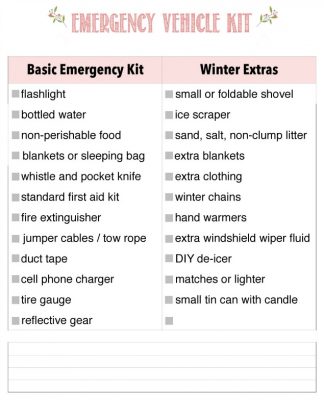Learn how to prepare your vehicle for winter and keep your family safe with these 6 simple tips. Free printables and an emergency vehicle kit checklist are included to help keep you organized.
This year has been one of the coldest, snowiest winters that I can remember {and we’re not even a month in!}. Usually we’ll get a day or two of snow per year and a few odd cold spells, but it doesn’t stick around for long. The snow started this year, however, at the beginning of December and still hasn’t left!
How To Prepare Your Car for Winter Driving
Winter weather can be hard on your car, so it’s important to do some basic steps to protect your vehicle and ensure that it’s prepared for those winter conditions. Follow this checklist below to get your care in tip-top winter shape! {NOTE: Always check your owner’s manual for any specific details about your car’s components.}
Start with a Winter Maintenance
Schedule a seasonal maintenance check on your vehicle to keep on top of any minor repairs that may be needed. Make sure your battery, brakes, lights, cooling and heating systems, electrical systems, and belts and hoses are all in good working order. Since the colder weather can cause your vehicle’s oil to thicken, change the oil just prior to the winter months to help keep the oil flowing easily through your engine. To keep track of all of your repairs and maintenance work, print off this maintenance log and keep it in your vehicle or family binder.
DOWNLOAD THE VEHICLE MAINTENANCE LOG HERE {KILOMETERS}
DOWNLOAD THE VEHICLE MAINTENANCE LOG HERE {MILES}
Check Your Tires
When the weather starts to turn, it’s time to check those tires! Make sure that you have the appropriate tires on your car to meet the winter driving conditions in your region, and check the tire’s tread indicator to ensure that they’ll last through the season. All-season tires {or 3 season tires} are designed for weather conditions above 7 degrees celsius {or 45 degrees fahrenheit}. If you have temperatures below that, you will need all-weather or winter tires installed. Remember to check your tire pressure regularly {and don’t forget about the spare tire!}. Tire pressure tends to go down with colder temperates making your tires more susceptible to damage.
Do Regular Fluid Checks
Make sure your windshield wiper fluid and anti-freeze is topped up. You may also wish to carry an extra supply in your trunk.
Keep your Windshield and Windows Clear
Make sure that you clear any snow and ice from all windows, lights, and mirrors, as well as the hood and the roof of your vehicle, before driving. This will allow for clear visibility and will ensure that a big pile of snow doesn’t go flying off your car while you’re driving! If your area is prone to heavy snow and ice, change your wipers to winter blades. These are heavier and can help clear any snow and ice from your windshield easier. If you’re battling the cold weather you might also want to read this post on how to create this simple DIY car de-icer.
Give Your Car Some T.L.C.
Ice, salt, and slush can wreak havoc on your car. To help avoid rusting, wash and apply a fresh coat of wax to your vehicle prior to the winter season. Your car should also be washed regularly throughout the winter {especially the underbelly} to help protect your car against the winter elements and to keep your windshields, mirrors, and lights clean for optimum visibility.
Keep a Winter Emergency Kit in Your Car
It’s always a good idea to keep a basic emergency kit in your car at all times, but there are some additional items that you should add for the colder months. You can purchase pre-made car emergency kits or gather the supplies on your own. Use the list below and evaluate what you need for your area and driving conditions. You can also find a free printable checklist to keep in your car or add to your family binder.
What should a car emergency kit include?
- water {ideally a 3 day supply}
- calorie dense, non-perishable food such as energy bars, nuts, etc.
- blankets or a sleeping bag {a light, heat reflective blanket is ideal}
- wind-up flashlight or a flashlight {ideally waterproof} with extra batteries
- standard first aid kit with seatbelt cutter
- whistle
- fire extinguisher
- jumper cables
- duct tape
- tow rope
- tire gauge
- reflective warning triangles and reflective vest
- matches or lighter and a candle and small tin can {this will help to provide some warmth when you cannot run the car}
- small pocket knife
Additional items that you may want to add for winter driving {depending on your area’s weather conditions}:
- small {or foldable} shovel
- ice scraper
- 2 bags of sand, salt, non-clumping kitty litter, or other traction aid
- extra blankets and extra clothing {hat, socks, mittens, etc.}
- winter chains
- hand warmers
DOWNLOAD THE EMERGENCY VEHICLE KIT CHECKLIST HERE
The post How to Prepare Your Car for Winter appeared first on Clean and Scentsible.

